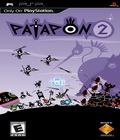Genre: Rhythm/Action
Publisher: SCEA
Developer: SCEI
Release Date: May 5, 2009
Patapon for the PSP introduced the most desirable trick in portable games: simple game mechanics that can be played deep, for as little as 15 minutes or as long as several hours. When Patapon 2 arrives in a couple of months, Japan Studio will bring additional features and content to fans of the original.
Like Patapon, this sequel showcases the PSP developer's uncomplicated yet sublimely sophisticated approach to game graphics. Patapon 2 is, with the exception of some load and menu screens, all line art filled in muted colors. In fact, Patapon 2 looks a lot like a graphic novel, which is hardly an unfavorable comparison these days. Highly stylized graphics suit this title far more than jaw-dropper images. As you quickly get into the game behind the graphics, you'll find the visuals to be mere road signs to your mission progress.
Processor-intensive graphics would go largely ignored in a game like this. Audio and music, on the other hand, are of paramount importance, and Patapon 2 returns with a sound production as good as or better than the original. From the signature drumbeats to the chorus of Hatapons singing their refrains, everything is clear as a bell and as loud as you'd like, even played through the PSP's small speakers. If you're wearing headphones, expect an even more immersive experience.
Portable gamers familiar with Patapon will have no problem picking up the sequel as if they've just left off the first game. There's an easy mode for those playing the franchise for the first time, but if you've played the original to any extent you won't need it, and you may prefer to move on ahead in difficulty. As usual, the Patapon mechanics approach mastery. On the one hand, it's as simple as pressing the face buttons to pound out drumbeats for your diminutive troops, so it's a rhythm game. Banging out these tattoos signals your soldier classes to do things like advance, attack and defend, so now it becomes a real-time strategy game suited for handheld play. Progress far enough, collect enough experience, win plenty of battles, and you can upgrade your varied units to higher levels, making them far more useful in combat. OK, so it has elements of an RPG.
In fair consideration of Patapon 2, it's all these things and none of them. Although there are modal aspects to the game, you don't often feel like you're confined in a certain modality. When you're playing the rhythm part, you're also deciding the RTS portion of gameplay. You're not stopping everything to duplicate the drumbeats and then watch your troops roll out accordingly; it's all happening at the same time. Patapon 2 neither looks nor plays like a succession of mini-games or tricky puzzles for the gamer to decipher, which is a clear accomplishment. Without doubt, the series could have rather easily devolved into a sort of mincing, readily dismissed gameplay.
Rather than rework a winning formula, the game's developers decided to give those already indoctrinated in the title's delights more of what they love. The progression and overall design of Patapon 2 is the same as Patapon, and I suspect most fans of the franchise will be thrilled rather than disappointed. Further, with such a delicate balance of design elements at work in quite the unique game, there's inherent danger in changing the gameplay. Perhaps the best solution has been discovered, and to change this in the sequel just for the sake of changing it may yield a game inferior in all respects to the original.
Patapon 2 does, however, add something significant without detracting from gameplay: an all-new multiplayer mode. The new game will support up to four players, with AI units capable of filling in for up to three live opponents. Multiplayer missions are similar to those found in the single-player campaign, although streamlined to tolerate fewer units and individual player control of each unit. There are also points in the multiplayer missions, where all the players must coordinate their drumming to achieve certain goals. Patapon 2's multiplayer mode is limited to ad hoc participation (local, not online), but the game supports the PSP's oft-overlooked game-sharing feature. As you'll recall, game-sharing means only the host PSP must own a copy of the game in order to create ad hoc multiplayer matches.
Patapon 2 will hit U.S. store shelves in mid-May, so gamers can look forward to a long summer of drum-banging strategy.
More articles about Patapon 2











 Patapon is a 2D platform/action adventure game that transforms players into a mystical leader in charge of guiding a tribe of small, quirky warriors called Patapons.
Patapon is a 2D platform/action adventure game that transforms players into a mystical leader in charge of guiding a tribe of small, quirky warriors called Patapons.




















